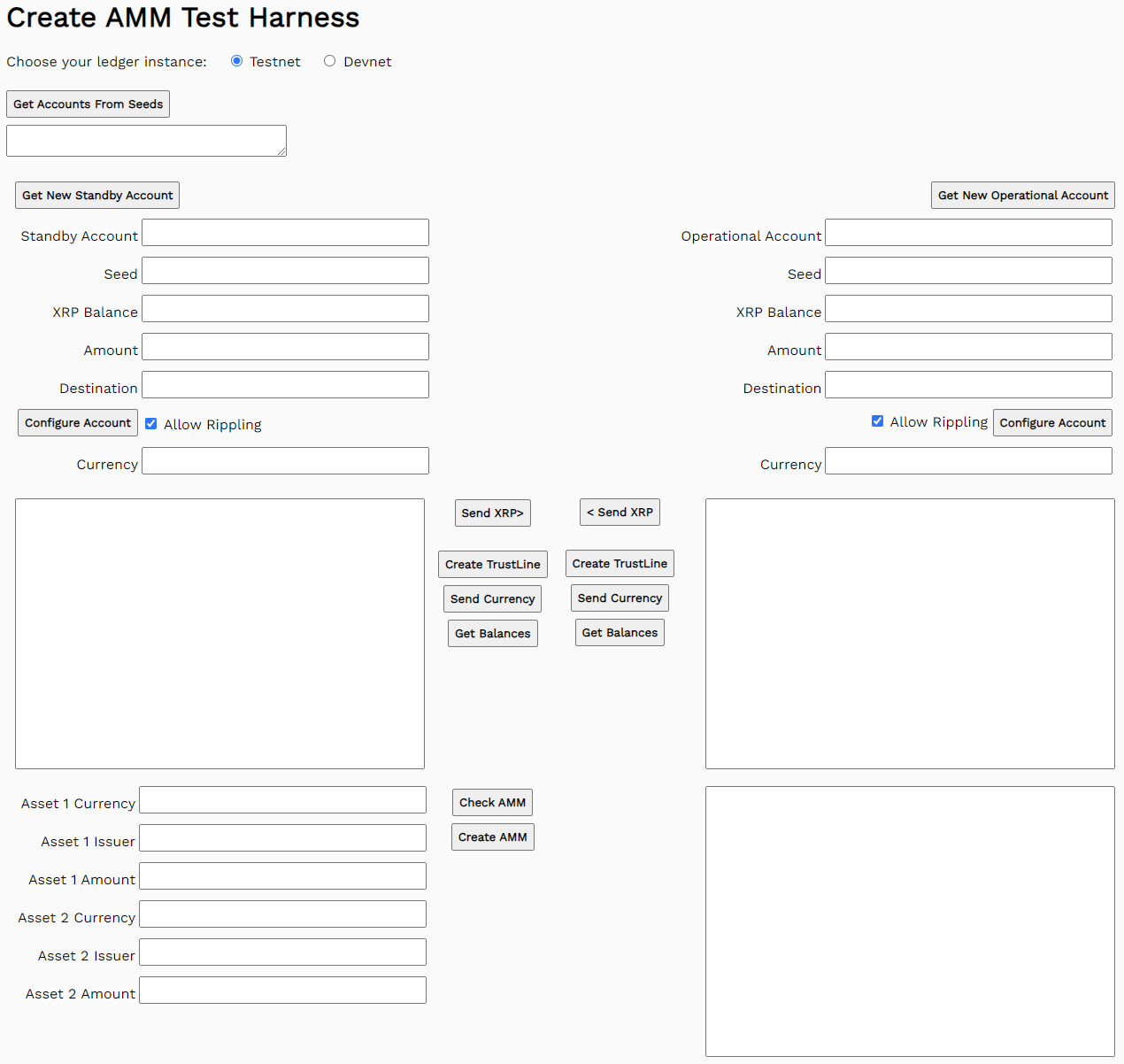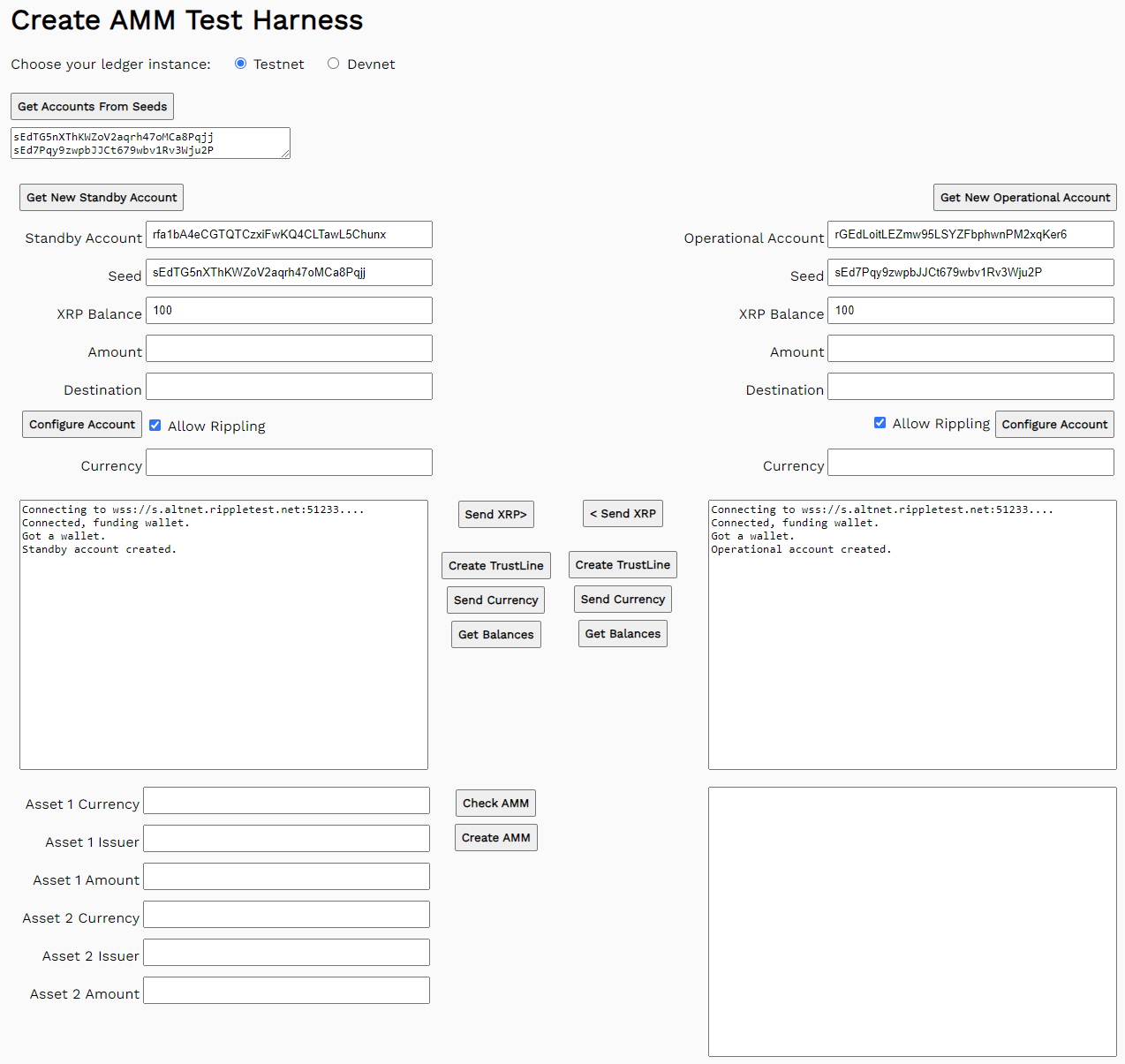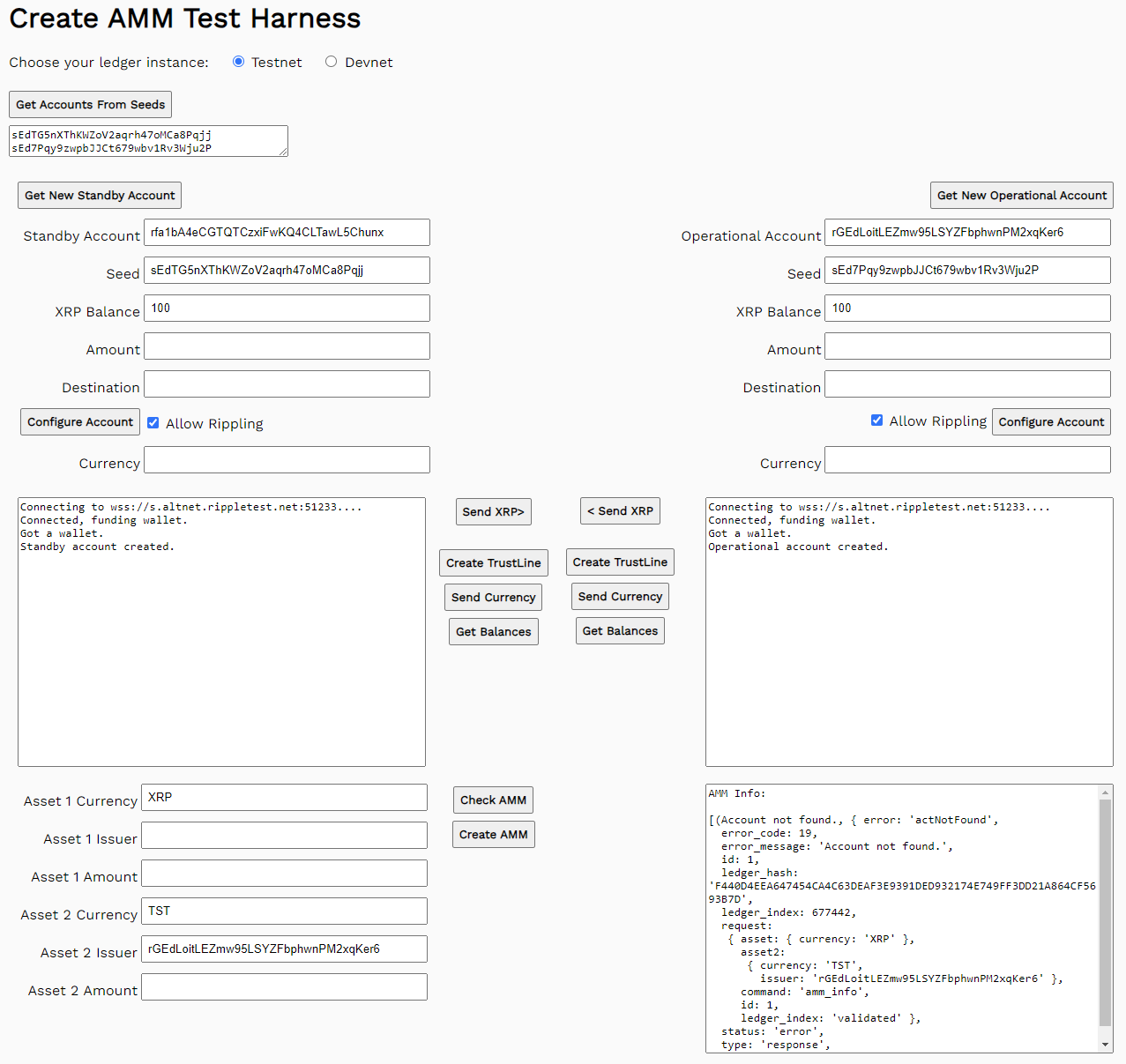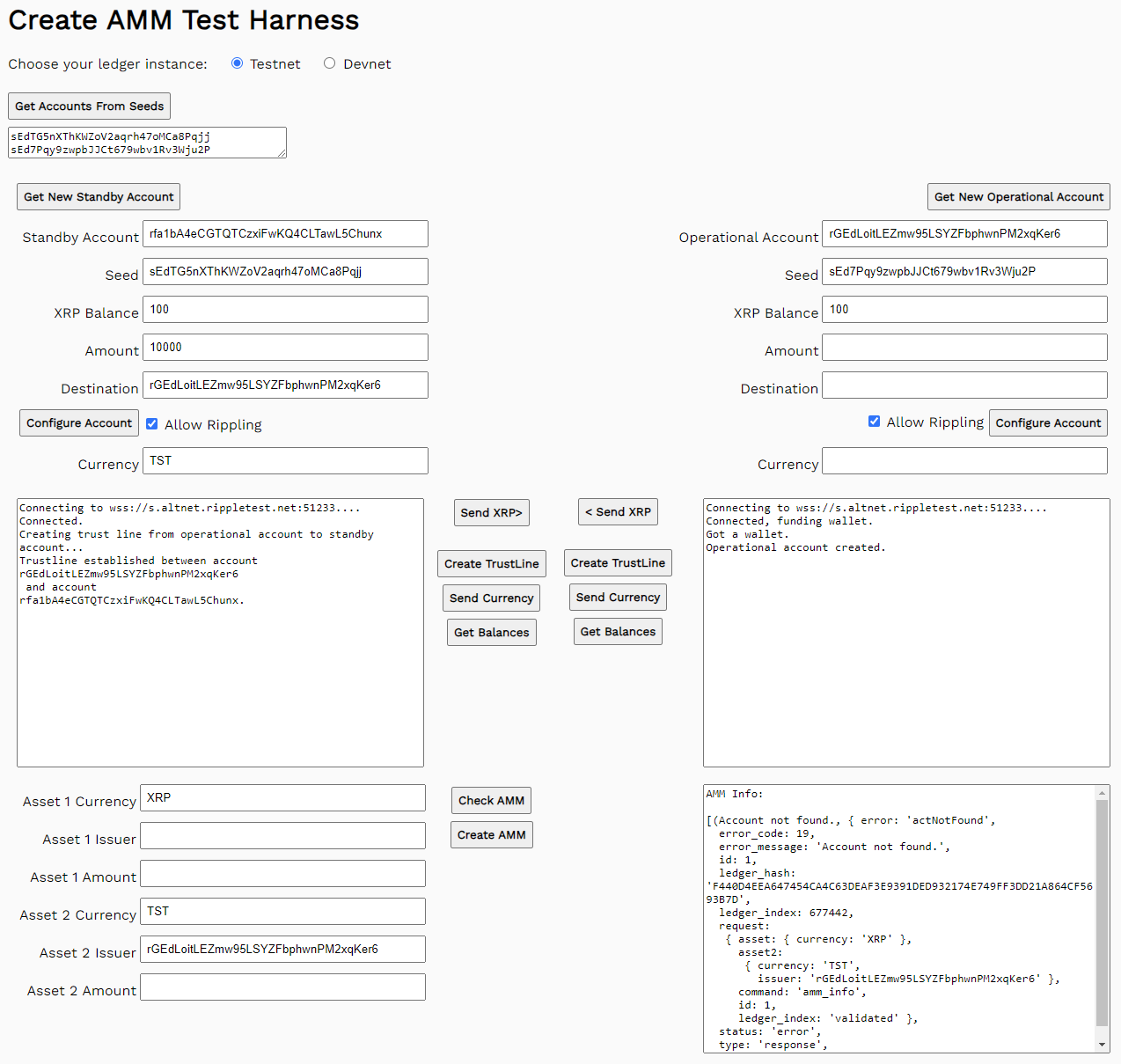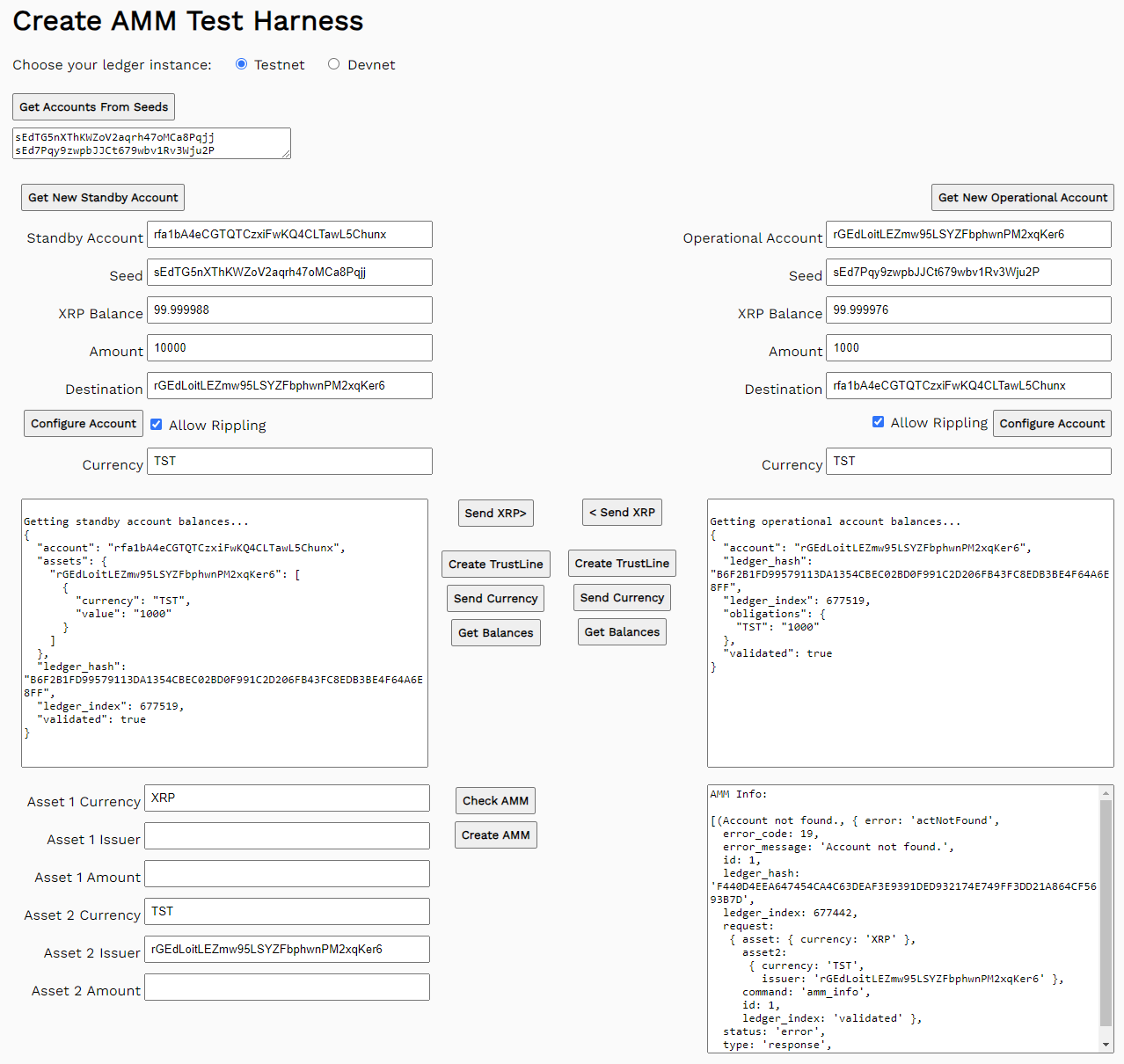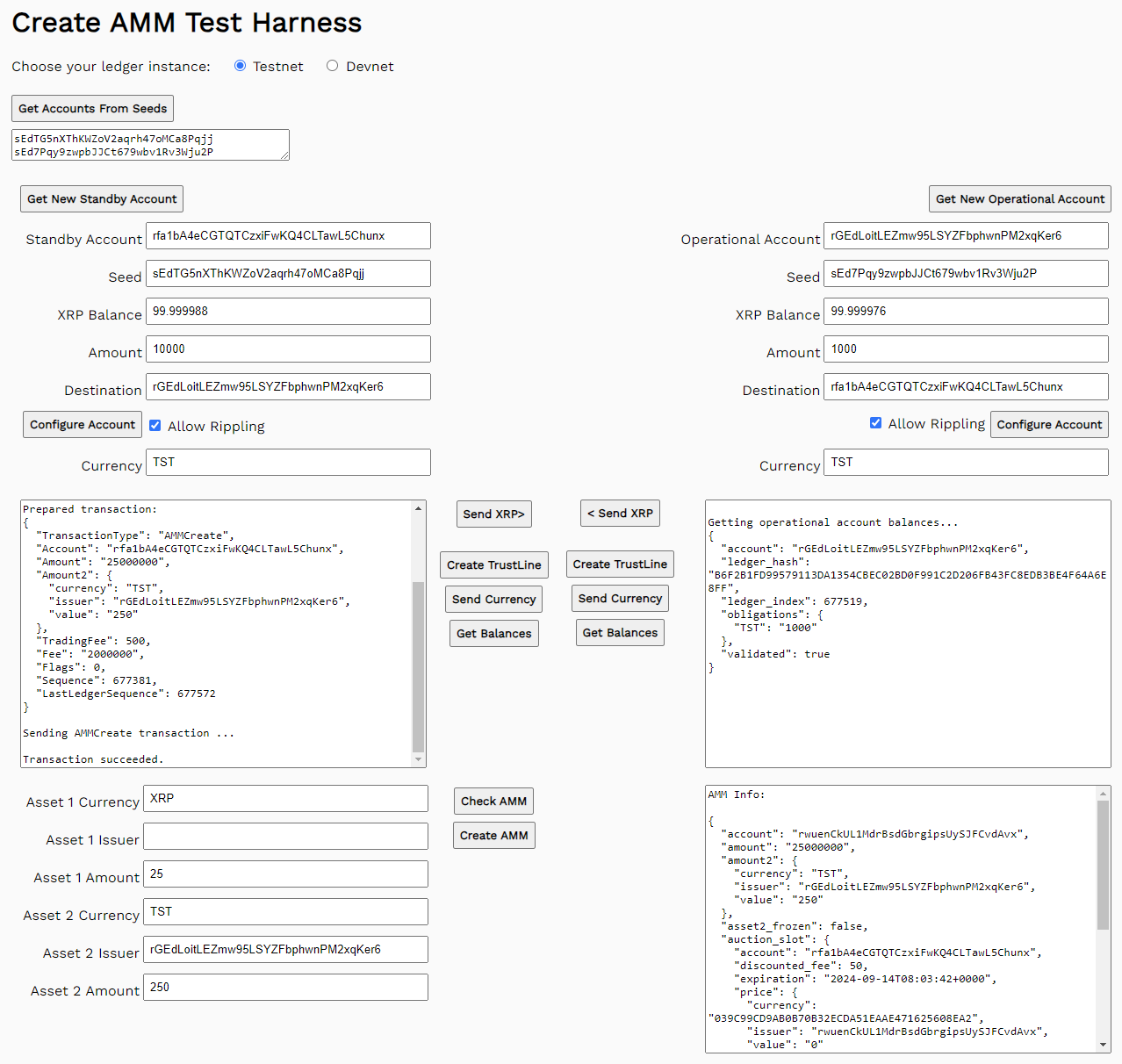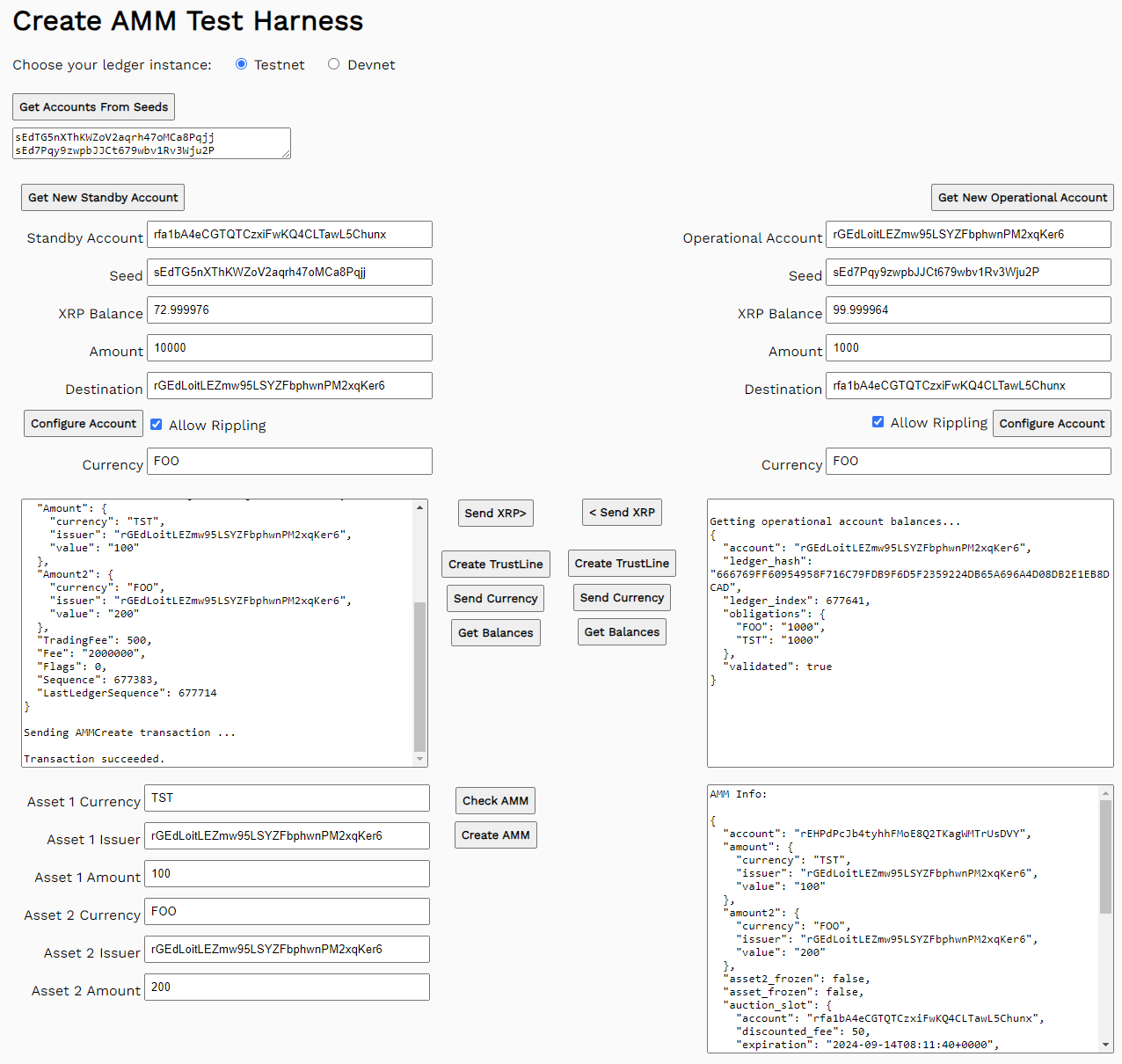This example shows how to:
- Check if an AMM pair exists.
- Issue a token.
- Create an AMM pair with the issued tokens and XRP.
- Create another AMM pair with two issued tokens.
You can download the Quickstart Samples archive to try each of the samples in your own browser.
Without the Quickstart Samples, you will not be able to try the examples that follow.
- Open
11.create-amm.htmlin a browser. - Select Testnet or Devnet
- Get test accounts.
- If you have existing account seeds:
- Paste account seeds in the Seeds field.
- Click Get Accounts from Seeds.
- If you don't have account seeds:
- Click Get New Standby Account.
- Click Get New Operational Account.
- If you have existing account seeds:
Check if an AMM pair already exists. An AMM holds two different assets: at most one of these can be XRP, and one or both of them can be tokens.
- Enter a currency code in the Asset 1 Currency field. For example,
XRP. - Enter a second currency code in the Asset 2 Currency field. For example,
TST. - Enter the operational account address in the Asset 2 Issuer field.
- Click Check AMM.
Create a trustline from the operational account to the standby account. In the standby account fields:
- Enter a maximum transfer limit in the Amount field, such as 10,000.
- Enter the operational account address in the Destination field.
- Enter a currency code in the Currency field. For example,
TST. - Click Create Trustline.
Send issued tokens from the operational account to the standby account. In the operational account fields:
- Select Allow Rippling and click Configure Account.Note
This enables the
defaultRippleflag on the issuing account, which is set tofalseby default. You need to enable this in order to trade tokens issued by the account. See Configure Issuer Settings to learn more. - Enter a value in the Amount field, up to the maximum transfer amount you set in the trustline.
- Enter the standby account address in the Destination field.
- Enter the currency code from the trustline in the Currency field.
- Click Send Currency.
Create a new AMM pool with XRP and the issued tokens.
- Enter
XRPin the Asset 1 Currency field. - Enter an amount of XRP in the Asset 1 Amount field. Save some
XRPfor later use in the tutorial. - Enter the currency code of your issued tokens in the Asset 2 Currency field.
- Enter the operational account address in the Asset 2 Issuer field.
- Enter an amount in the Asset 2 Amount field.
- Click Create AMM.
Save the seed values of the standby and operational accounts for subsequent AMM tutorials.
Create a second AMM pool with two issued tokens.
- Repeat the steps from Create Trustline, using a different currency code. For example,
FOO. - Repeat the steps from Issue Tokens, using the second currency.
- Enter the first currency code in the Asset 1 Currency field.
- Enter the operational account address in the Asset 1 Issuer field.
- Enter an amount in the Asset 1 Amount field.
- Enter the second currency code in the Asset 2 Currency field.
- Enter the operaional account address in the Asset 2 Issuer field.
- Enter an amount in the Asset 2 Amount field.
- Click Create AMM.
You can open ripplex11-create-amm.js from the Quickstart Samples to view the source code.
This sends the AMMCreate transaction and creates a new AMM, using the initial assets provided. The code checks the token currency fields and formats the AMMCreate transaction based on the combination of XRP and custom tokens.
async function createAMM() {Connect to the XRP Ledger.
let net = getNet()
const client = new xrpl.Client(net)
results = `\n\nConnecting to ${getNet()} ...`
standbyResultField.value = results
await client.connect()
results += '\n\nConnected.'
standbyResultField.value = resultsGet the AMM information fields.
const standby_wallet = xrpl.Wallet.fromSeed(standbySeedField.value)
const asset1_currency = asset1CurrencyField.value
const asset1_issuer = asset1IssuerField.value
const asset1_amount = asset1AmountField.value
const asset2_currency = asset2CurrencyField.value
const asset2_issuer = asset2IssuerField.value
const asset2_amount = asset2AmountField.valueFormat the AMMCreate transaction based on the combination of XRP and tokens.
let ammCreate = null
results += '\n\nCreating AMM ...'
standbyResultField.value = results
// AMMCreate requires burning one owner reserve. We can look up that amount
// (in drops) on the current network using server_state:
const ss = await client.request({"command": "server_state"})
const amm_fee_drops = ss.result.state.validated_ledger.reserve_inc.toString()
if (asset1_currency == 'XRP') {
ammCreate = {
"TransactionType": "AMMCreate",
"Account": standby_wallet.address,
"Amount": JSON.stringify(asset1_amount * 1000000), // convert XRP to drops
"Amount2": {
"currency": asset2_currency,
"issuer": asset2_issuer,
"value": asset2_amount
},
"TradingFee": 500, // 500 = 0.5%
"Fee": amm_fee_drops
}
} else if (asset2_currency =='XRP') {
ammCreate = {
"TransactionType": "AMMCreate",
"Account": standby_wallet.address,
"Amount": {
"currency": asset1_currency,
"issuer": asset1_issuer,
"value": asset1_amount
},
"Amount2": JSON.stringify(asset2_amount * 1000000), // convert XRP to drops
"TradingFee": 500, // 500 = 0.5%
"Fee": amm_fee_drops
}
} else {
ammCreate = {
"TransactionType": "AMMCreate",
"Account": standby_wallet.address,
"Amount": {
"currency": asset1_currency,
"issuer": asset1_issuer,
"value": asset1_amount
},
"Amount2": {
"currency": asset2_currency,
"issuer": asset2_issuer,
"value": asset2_amount
},
"TradingFee": 500, // 500 = 0.5%
"Fee": amm_fee_drops
}
}Prepare the transaction for submission. Wrap the submission in a try-catch block to handle any errors.
try {
const prepared_create = await client.autofill(ammCreate)
results += `\n\nPrepared transaction:\n${JSON.stringify(prepared_create, null, 2)}`
standbyResultField.value = results
standbyResultField.scrollTop = standbyResultField.scrollHeight Sign the prepared transaction using the standy account wallet.
const signed_create = standby_wallet.sign(prepared_create)
results += `\n\nSending AMMCreate transaction ...`
standbyResultField.value = results
standbyResultField.scrollTop = standbyResultField.scrollHeightSubmit the signed transaction to the XRPL.
const amm_create = await client.submitAndWait(signed_create.tx_blob)
if (amm_create.result.meta.TransactionResult == "tesSUCCESS") {
results += `\n\nTransaction succeeded.`
} else {
results += `\n\nError sending transaction: ${JSON.stringify(amm_create.result.meta.TransactionResult, null, 2)}`
}
} catch (error) {
results += `\n\n${error.message}`
}Report the transaction results in the standby account log. Run the checkAMM() function to update the AMM's information in the AMM log.
standbyResultField.value = results
standbyResultField.scrollTop = standbyResultField.scrollHeight
checkAMM()
client.disconnect()
}This checks if an AMM already exists. While multiple tokens can share the same currency code, each issuer makes them unique. If the AMM pair exists, this responds with the AMM information, such as token pair, trading fees, etc.
async function checkAMM() {Connect to the XRP Ledger.
let net = getNet()
const client = new xrpl.Client(net)
await client.connect()Get the AMM info fields. When checking an AMM, you only need the currency code and issuer.
// Gets the issuer and currency code
const asset1_currency = asset1CurrencyField.value
const asset1_issuer = asset1IssuerField.value
const asset2_currency = asset2CurrencyField.value
const asset2_issuer = asset2IssuerField.valueFormat the amm_info command based on the combination of XRP and tokens.
let amm_info_request = null
// Get AMM info transaction
if (asset1_currency == 'XRP') {
amm_info_request = {
"command": "amm_info",
"asset": {
"currency": "XRP"
},
"asset2": {
"currency": asset2_currency,
"issuer": asset2_issuer
},
"ledger_index": "validated"
}
} else if (asset2_currency =='XRP') {
amm_info_request = {
"command": "amm_info",
"asset": {
"currency": asset1_currency,
"issuer": asset1_issuer
},
"asset2": {
"currency": "XRP"
},
"ledger_index": "validated"
}
} else {
amm_info_request = {
"command": "amm_info",
"asset": {
"currency": asset1_currency,
"issuer": asset1_issuer
},
"asset2": {
"currency": asset2_currency,
"issuer": asset2_issuer
},
"ledger_index": "validated"
}
}Submit the request in a try-catch block and update the AMM log.
try {
const amm_info_result = await client.request(amm_info_request)
ammInfo = `AMM Info:\n\n${JSON.stringify(amm_info_result.result.amm, null, 2)}`
} catch(error) {
ammInfo = `AMM Info:\n\n${error}`
}
ammInfoField.value = ammInfo
client.disconnect()
}